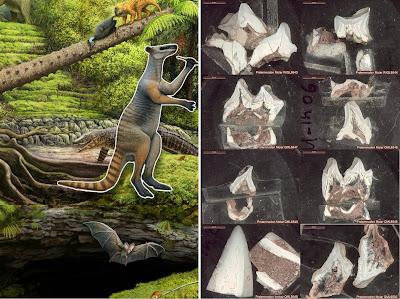 |
| Fossil Protemnodon individuals recovered from cave deposits at Mt Etna in Laurikainen Gaete, Dosseto, Arnold, Demuro, Lewis et Hocknull, 2025. |
Abstract
Understanding the factors that influence the geographic range of extinct megafaunal species is crucial for reconstructing their ecology and extinction dynamics. For extant herbivores, it has been demonstrated that large body mass provides the potential for greater geographic range. Allometric scaling relationships are observed in placental mammals but have not been well-established for marsupials, in particular, extinct marsupial megafauna. Here, we employ a phylogenetic generalised least squares regression model using extant macropodids to estimate home ranges for individuals from the extinct genus Protemnodon. The regression model predicts a mean home range of 11.6 ± 5.8 km2 This prediction, centred on Mt Etna caves, incorporates several distinct geological features with variable, known 87Sr/86Sr isotope ratios. Fossil Protemnodon individuals recovered from cave deposits at Mt Etna returned 87Sr/86Sr values similar to that of the host limestone, in which the cave systems formed, and the broader Mount Alma Formation. This similarity suggests that individuals foraged close to where they were fossilised, indicating a smaller home range than predicted. Smaller home ranges for individuals with a large body-mass were unexpected, attributed to a unique combination of individual behaviour, diet and/or locomotion regime within stable rainforest environments. Our results suggest that, foraging ranges in marsupial megaherbivores may be more strongly associated with environmental quality rather than body mass. New in-situ uranium-thorium and single-grain TT-OSL ages refine, and are in agreement with, previous interpretations of chronology, indicating that rainforest-adapted fauna persisted at Mt Etna until at least 280 ka. We propose that small home ranges in a stable environment, such as rainforests, predisposed these megafauna macropodids to extinction after 280ka, driven by an increasingly dry and unstable climate. Our results underscore the need for regionally specific biologies of individuals, populations and species when considering extinction pathways for Pleistocene fauna.
 |
| Cross sections of megafauna enamel. Samples QML1311H-WIGL8543 to QML1312-WIGL8554. Strontium transects can be identified by a series of large depressions running along the enamel/dentine. |
Conclusions:
New TT-OSL ages and open system U-Th ages support previous site chronologies established for the Mt Etna caves, and further constrain fossil accumulation in stratigraphic units QML1311H, QML1311C/D, to ~ 280 – 330 ka. Whilst linear regression models predict species of Protemnodon should have occupied relatively large ranges, strontium isotope measurements of teeth indicate that Protemnodon from Mt Etna Caves had a limited foraging range with movements restricted to the local Mount Alma Formation, with the exception of one specimen originating at least 1 km away. Limited foraging ranges and therefore home range in Mt Etna Protemnodon contrast modelled ranges based on body mass. These differences are suggested to have been driven by resource availability, dietary preferences, and/or locomotory biomechanics, that limited the terrestrial dispersal capacity. Limited foraging ranges support conclusions drawn from extant macropodids suggesting foraging ranges may be more strongly associated with climate and environment. There is potential these limiting ranges may have also been a contributing factor to extinction of Protemnodon at Mt Etna caves. Localised, restricted, populations of Protemnodon may have been well-adapted to a closed-forest environment, however, they were unable to sustain this as intensifying aridification and resource degradation, predisposed them to localised extinction due to their limited dispersal capabilities.
Christopher Laurikainen Gaete, Anthony Dosseto, Lee Arnold, Martina Demuro, Richard Lewis and Scott Hocknull. 2025. Megafauna Mobility: Assessing the Foraging Range of an extinct macropodid from central eastern Queensland, Australia. PLoS ONE. 20(4): e0319712. DOI: doi.org/10.1371/journal.pone.0319712 [April 23, 2025]
https://theconversation.com/fossil-teeth-show-extinct-giant-kangaroos-spent-their-lives-close-to-home-and-perished-when-the-climate-changed-250057

